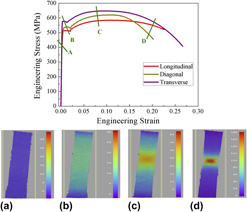Crossref Citations
This article has been cited by the following publications. This list is generated based on data provided by
Crossref.
Wang, Gang
Yin, Limeng
Yao, Zongxiang
Wang, Jinzhao
Jiang, Shan
Zhang, Zhongwen
and
Zuo, Cunguo
2019.
The Evolution and Distribution of Microstructures in High-Energy Laser-Welded X100 Pipeline Steel.
Materials,
Vol. 12,
Issue. 11,
p.
1762.
Liu, Ziyun
Gao, Qiuzhi
Zhang, Hailian
Luo, Shaohua
Zhang, Xin
Li, Wang
Jiang, Yujiao
and
Li, Huijun
2019.
EBSD analysis and mechanical properties of alumina-forming austenitic steel during hot deformation and annealing.
Materials Science and Engineering: A,
Vol. 755,
Issue. ,
p.
106.
Asadipoor, M.
Pourkamali Anaraki, A.
Kadkhodapour, J.
Sharifi, S.M.H.
and
Barnoush, A.
2020.
Macro- and microscale investigations of hydrogen embrittlement in X70 pipeline steel by in-situ and ex-situ hydrogen charging tensile tests and in-situ electrochemical micro-cantilever bending test.
Materials Science and Engineering: A,
Vol. 772,
Issue. ,
p.
138762.
Chen, Shih-Che
Huang, Cheng-Yao
Wang, Yuan-Tsung
Huang, Ching-Yuan
and
Yen, Hung-Wei
2020.
Role of the crystallographic texture in anisotropic mechanical properties of a newly-developed hot-rolled TRIP steel.
Materials Science and Engineering: A,
Vol. 790,
Issue. ,
p.
139683.
Yang, Yuzhao
Fan, Lixia
and
Xu, Cheng
2020.
The microstructure, texture evolution and plasticity anisotropy of 30SiMn2MoVA high strength alloy steel tube processed by cold radial forging.
Materials Characterization,
Vol. 169,
Issue. ,
p.
110641.
Giarola, J.M.
Calderón-Hernández, J.W.
Quispe-Avilés, J.M.
Avila, J.A.
and
Bose Filho, W.W.
2021.
Hydrogen-induced cracking and corrosion behavior of friction stir welded plates of API 5L X70 pipeline steel.
International Journal of Hydrogen Energy,
Vol. 46,
Issue. 55,
p.
28166.
Ding, Chao
Liu, Jinxu
Ning, Bo
Huang, Manli
and
Wu, Huibin
2023.
Enhanced strength-plasticity matching of lamellar 1 GPa-grade dual-phase steels via cyclic intercritical quenching.
Journal of Materials Research and Technology,
Vol. 22,
Issue. ,
p.
3115.
Dzioba, Ihor
Zvirko, Olha
Pała, Robert
and
Oliynyk, Oleksandr
2024.
Assessment of the Structural Integrity of the Portal Crane Elements After Long-Term Operation.
Materials,
Vol. 17,
Issue. 24,
p.
6133.
Vaka, Harika
Warwick, Cyril Marcus
and
Clyne, Trevor William
2024.
Profilometry‐Based Indentation Plastometry and Uniaxial Testing of Pipelines: Detection of In‐Plane Anisotropy and Potential for Simplification of Test Procedures.
steel research international,
Vol. 95,
Issue. 8,
Mirone, Giuseppe
Barbagallo, Raffaele
Bua, Giuseppe
Licignano, Pietro
and
Tedesco, Michele Maria
2024.
An Enhanced Approach for High-Strain Plasticity in Flat Anisotropic Specimens with Progressively Distorting Neck Sections.
Metals,
Vol. 14,
Issue. 5,
p.
578.
Goncalves Rodrigues, Maria Veronica
Siciliano, Fulvio
Aranas, Clodualdo
da Silva Lima, Marcos
de Carvalho Paes Loureiro, Rodrigo
Reis, Gedeon Silva
Silva, Eden Santos
Paiva Leão, Pablo Bruno
Ferreira, João Carlos
Gomes de Abreu, Hamilton Ferreira
and
Rodrigues, Samuel Filgueiras
2024.
Evidence of dynamic ferrite transformation during thermomechanical simulation of an X70 microalloyed steel above Ae3 temperature.
Journal of Materials Research and Technology,
Vol. 30,
Issue. ,
p.
3675.
Liu, Ling
Chen, Fuxiao
Sun, Hongying
Guo, Junqing
Xiang, Nan
and
Huang, Tao
2025.
Characterization of Microstructure and Tensile Properties of a New Alumina-Forming Austenitic Alloy at High Temperatures.
Journal of Materials Engineering and Performance,
Vol. 34,
Issue. 1,
p.
606.

 $\left[ {\bar{1}\bar{1}2} \right]$ component was obviously larger than the (111)
$\left[ {\bar{1}\bar{1}2} \right]$ component was obviously larger than the (111) $\left[ {1\bar{2}1} \right]$ component in the γ-fiber texture during tensile deformation.
$\left[ {1\bar{2}1} \right]$ component in the γ-fiber texture during tensile deformation.

